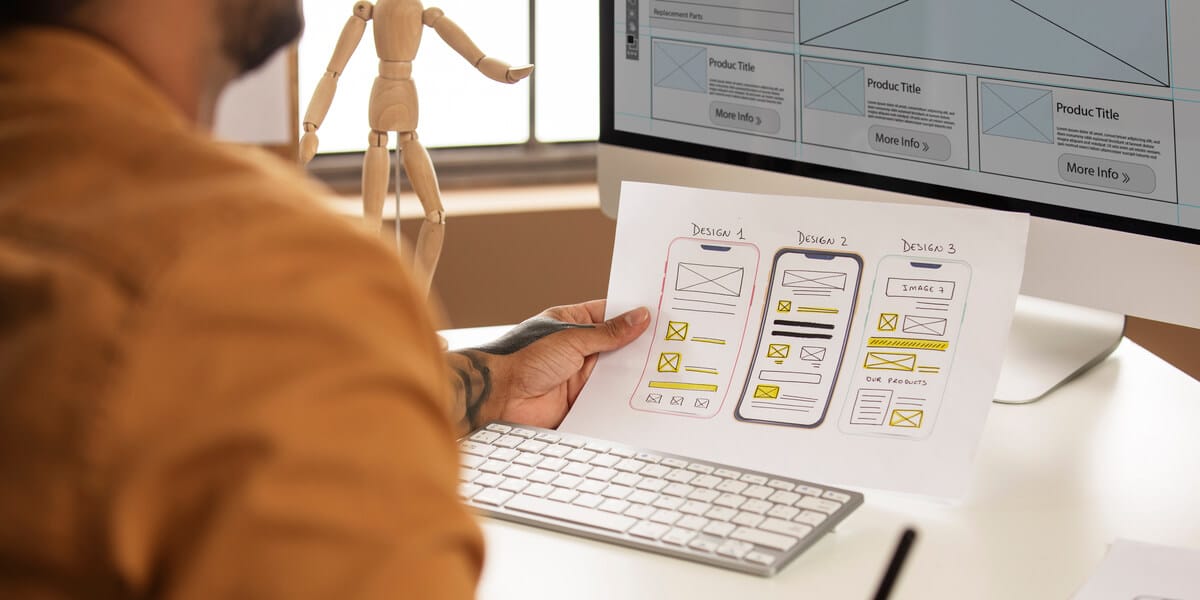
Content marketing in SEO. How to create content that attracts organic traffic?
14 April 2023
Artificial intelligence in e-commerce. Personalization of the shopping experience
5 May 2023
A finely developed user interface, or UI, is majorly critical to the success of an application, website, or product in today’s digital age. It has been written, keeping focus on what UI design incorporates, the types of UI designs available, the variance between UI and UX, and some recommended practices in this area.
What is UI Design?
UI design, otherwise referred to as User Interface Design, is the process of making interactive, aesthetically pleasing, and usable user interfaces for website, mobile application, or desktop system platforms. The purpose of any good UI design would be to enable users to easily and effectively use the interface while still raking in some very important information.
UI design types
The different types of user interface designs differ by context and platform they are designed for. A graphical user interface is a common type of user interface that employs graphics, icons, buttons, and other visual elements to facilitate users’ interaction with the system. Graphical User Interface(GUI).
Mobile application UI—What the requirements are in creating a user interface for a mobile application, considering the limitations in terms of screen size and touch screen gestures, call for layout, button, and navigation optimization to make everything seamlessly fall into place for a great user experience.
User Interface for Websites: In designing a user interface for a website, it considers a lot of things: responsiveness, navigation options available, content layout, interaction, consistency with brand and adaptiveness to the user’s expectations and preferences.
UI vs. UX – differences
Although UI Design (user interface design) and UX Design (user experience design) are closely related, there are some differences between them:
- UI Design mainly focuses on designing the visual and interactive elements of the user interface, such as buttons, icons, colors and layout. UX Design, on the other hand, focuses on the entire process of user interaction with the product, including user research, prototyping, testing and optimization.
- UI Design focuses on aesthetic and interactive aspects, aiming to create a pleasant and intuitive user interface. UX Design, on the other hand, focuses on providing a satisfying user experience by understanding their needs, expectations and goals.
- UI Design is often more related to graphic and visual design, while UX Design combines elements of psychology, user research, and business strategies.
UI Design Best Practices
Here are a few best practices that one should remember in ensuring effective UI design.
Intuitive Navigation: Good navigation is important to the users since it makes the movement around the interface easy. Clear labels, buttons, and menus easily give users the information.
Responsiveness: The user interface shall be responsive, given that it is the mobile device era. Make sure all your elements are very clear to see and easily usable on mobile devices.
Provide visual consistency: Continuity is key to navigation and the identification of elements. This can be ensured through tight visual cohesiveness in brand identity and feel by a closely aligned color palette, typography, icons, and style.
Test and Optimize: One can learn about weaknesses and deficiencies in a UI by testing it regularly. Such tools as usability testing, user behavior analysis, and feedback will improve the interface continuously.
Understand Your Users: It means conducting user research through demographic analysis, creating personas to understand better the expectations and needs of users. At the interface level, all this information is brought into action with valuable solutions customized.
This thus plays a big role in the making of intuitive, aesthetic user interfaces. You will be able to come up with an interface that offers the best possible user experience and contributes to success in products, apps, and websites by following intuitive navigation, responsiveness, visual consistency, testing, and user understanding. Worth reminding oneself, good UI Design goes hand in glove with UX Design, which means user experience design covering the whole process of interaction for valuable use.
Now, the important thing is to learn the differences between both and be able to apply the right UI design techniques. Thoughtfully designed user interfaces can increase the degree of engagement of the user and raise conversions, thereby creating a positive brand image.
This dynamically developing industry generates new trends and tools; therefore, it’s crucial to get updated about the newest information and fresh practices. There are many super reputable industry portals—like Nielsen Norman Group, Smashing Magazine, or UX Collective—who share a lot of useful tips, articles, and case studies on UI Design.
UI design is a part of developing any successful product, app, or website. Good UI design would mean, therefore, developing an intuitive, attractive, and functional interface that provides some form of valuable user interaction. Best practices toward better results would include intuitive navigation and responsiveness, visual consistency, and testing and understanding the needs of users.
It pays to invest in UI design and be aware of the latest trends and instruments in this area to make user interfaces stand out on the market and give users a reason to be attracted. Properly designed interfaces increase value to both users and businesses by virtue of a positive user experience, which means higher customer engagement, conversion, and loyalty.


